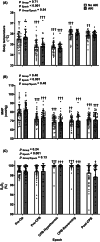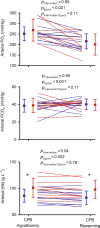Intraoperative hemodynamics and risk of cardiac surgery-associated acute kidney injury: An observation study and a feasibility clinical trial
- PMID: 37549882
- PMCID: PMC10947000
- DOI: 10.1111/1440-1681.13812
Intraoperative hemodynamics and risk of cardiac surgery-associated acute kidney injury: An observation study and a feasibility clinical trial
Abstract
Targeting greater pump flow and mean arterial pressure (MAP) during cardiopulmonary bypass (CPB) could potentially alleviate renal hypoxia and reduce the risk of postoperative acute kidney injury (AKI). Therefore, in an observational study of 93 patients undergoing on-pump cardiac surgery, we tested whether intraoperative hemodynamic management differed between patients who did and did not develop AKI. Then, in 20 patients, we assessed the feasibility of a larger-scale trial in which patients would be randomized to greater than normal target pump flow and MAP, or usual care, during CPB. In the observational cohort, MAP during hypothermic CPB averaged 68.8 ± 8.0 mmHg (mean ± SD) in the 36 patients who developed AKI and 68.9 ± 6.3 mmHg in the 57 patients who did not (p = 0.98). Pump flow averaged 2.4 ± 0.2 L/min/m2 in both groups. In the feasibility clinical trial, compared with usual care, those randomized to increased target pump flow and MAP had greater mean pump flow (2.70 ± 0.23 vs. 2.42 ± 0.09 L/min/m2 during the period before rewarming) and systemic oxygen delivery (363 ± 60 vs. 281 ± 45 mL/min/m2 ). Target MAP ≥80 mmHg was achieved in 66.6% of patients in the intervention group but in only 27.3% of patients in the usual care group. Nevertheless, MAP during CPB did not differ significantly between the two groups. We conclude that little insight was gained from our observational study regarding the impact of variations in pump flow and MAP on the risk of AKI. However, a clinical trial to assess the effects of greater target pump flow and MAP on the risk of AKI appears feasible.
Keywords: arterial pressure; cardiopulmonary bypass; clinical perfusion; pump flow; systemic oxygen delivery.
© 2023 The Authors. Clinical and Experimental Pharmacology and Physiology published by John Wiley & Sons Australia, Ltd.
Figures








References
-
- Hu J, Chen R, Liu S, Yu X, Zou J, Ding X. Global incidence and outcomes of adult patients with acute kidney injury after cardiac surgery: a systematic review and meta‐analysis. J Cardiothorac Vasc Anesth. 2016;30:82‐89. - PubMed
-
- Ishani A, Nelson D, Clothier B, et al. The magnitude of acute serum creatinine increase after cardiac surgery and the risk of chronic kidney disease, progression of kidney disease, and death. Arch Intern Med. 2011;171:226‐233. - PubMed
-
- Ow CPC, Ngo JP, Ullah MM, Hilliard LM, Evans RG. Renal hypoxia in kidney disease: cause or consequence? Acta Physiol (Oxf). 2018;222:e12999. - PubMed
-
- Evans RG, Lankadeva YR, Cochrane AD, et al. Renal haemodynamics and oxygenation during and after cardiac surgery and cardiopulmonary bypass. Acta Physiol (Oxf). 2018;222:e12995. - PubMed
Publication types
MeSH terms
Grants and funding
LinkOut - more resources
Full Text Sources
Medical

